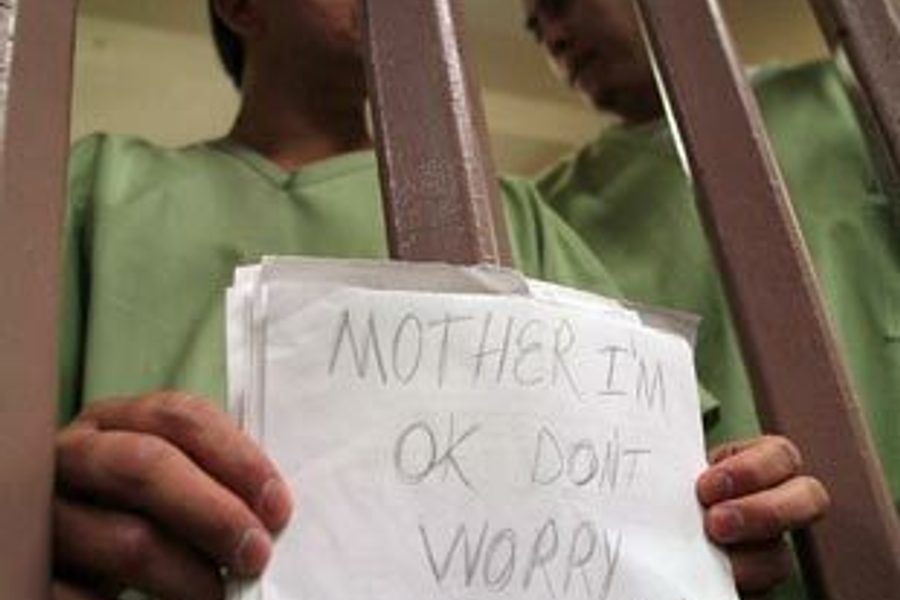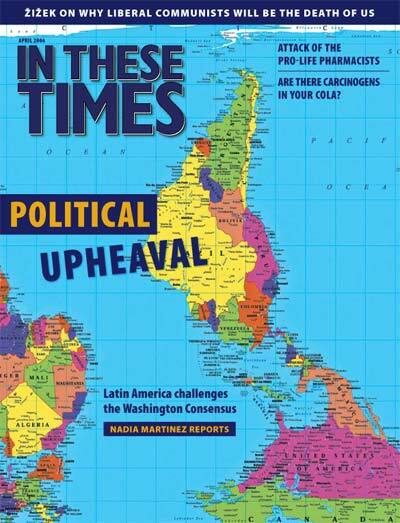Race Riot?
It’s far too easy to pin recent violence in the L.A. County Jail on ethnic tensions
Silja J.A. Talvi

When the nation’s largest jail system erupted in violence on Feb. 4, officials thought they would quickly bring the situation under control. L.A. County Jail correctional officers are trained in forms of riot control, and regularly drilled in the art of jail combat, complete with S.W.A.T.-style protective gear and access to an arsenal of lethal and “non-lethal” weaponry.
But this wasn’t the kind of inmate uprising that jail officials expected. For the better part of a month, inmates throughout the sprawling L.A. County Jail system tangled with one another in small-scale scuffles and large-scale battles. By late February, two dead inmates and hundreds of injured inmates later, jail officials believed they had finally contained the riot. But then violence broke out again on March 1, sending black and Latino inmates to the hospital. It seems unlikely to be the last episode of violence.
Most reporters covering the story embraced the “race riot” label, stressing that the animosities between African Americans and Latinos in jail had finally reached a fever pitch. But as the family members of inmates and a variety of civil rights and religious organizations tried to point out, focusing on the color and “raza” of warring inmates missed the larger picture: an overcrowded, overburdened and often dehumanizing method of incarceration.
Keeping the ‘savages’ apart
According to many jail and prison officials – L.A. County Sheriff Lee Baca included – race and gang segregation is an important tool for keeping high-violence-prone inmates out of situations where they can hurt or kill each other, as well as keeping guards as safe as possible in a dangerous environment.
The unintended result, however, is that segregation by race often forces members of one ethnic group into a gang-dominated setting where they must follow a predominant gang’s rules and expectations – or face severe retaliation. Combined with limited opportunities to exercise, study or participate in any kind of counseling or vocational training, the situation amounts to a recipe for disaster.
“These fights right now are the result of an interracial war, Latinos against African Americans,” Baca told National Public Radio on Feb. 13. “That’s a gang-related problem from South Central Los Angeles.”
Baca’s comments highlight serious gaps in his comprehension of the situation on the streets of Los Angeles. For one thing, intra-racial gang violence is far more likely in any neighborhood than are skirmishes between ethnic groups, whether it’s the Norteños vs. the Sureños, or the Bloods vs. the Crips. For another, these problems are not limited to South Central Los Angeles. But apparently it’s still easier to point the finger toward that part of L.A. County than to acknowledge the presence of gangs from Venice to East Los Angeles, Long Beach to Hollywood, and everywhere in between.
A nuanced understanding of gang life and culture is sorely lacking on the part of both the jail system and the press. L.A. gang culture – and Southern and Northern California gang culture more broadly – has become so entrenched that it has become intergenerational, with 65-year-old grandfathers doing time alongside their 20-something grandchildren. In many neighborhoods, it is expected that young adult men (and many young women) will be born into or gravitate toward one “family” or another for the sake of protection, identity, social status and the opportunity to participate in various illicit income-generating projects. Gang life offers family and community protection, a sense of identity and even steady employment in a city that otherwise affords little such stability to its poorest residents.
But these motivations are lost on political leaders who seem more comfortable dealing with the situation in terms of “containment,” rather than providing people with the education, jobs and respect they would need to escape the pitfalls of gang culture.
Interracial tensions between gangs do exist, but they are nowhere near the top of a gang’s priorities for taking care of their own. What happens when thousands of gang members – and unaffiliated petty criminals and substance abusers – are thrown into overcrowded jail dormitories doesn’t reflect the reality of L.A.’s rough street life so much as it creates an even uglier, more twisted life of its own.
A blunt instrument
As the rioting continued throughout February, officials put many jail inmates into lock-down: round-the-clock confinement to cells and dormitories. Inmates were unable to bathe, do laundry or visit with friends and family. In many jail facilities, lower-security-level dormitories where men of various ethnic backgrounds were previously able to room together were disbanded in favor of what could only be described as “race grouping.”
While such segregation was more extreme during the month of rioting than on a normal working day at the jail, the practice itself is nothing new to the L.A. County Jail system – or the California state prison system. In February 2005, the U.S. Supreme Court ruled that California had to abandon its state prison policy of automatically assigning new inmates to segregated cells, on the basis of their ethnicity, for as long as 60 days. The case, Johnson v. California, challenged the state to prove it had no “race-neutral” way to prevent interethnic violence. A similar lawsuit launched against Baca’s practices could bring an end to them in the L.A. County Jail system.
In November 2004, a confidential report prepared for the L.A. County Board of Supervisors warned of the potential for serious trouble if ongoing, long-term practices of racial segregation, compounded by overcrowding, weren’t addressed. Six months prior to the report, five inmates had already been killed over gang or race issues, although not under riot conditions.
In the first week of the rioting, the ACLU of Southern California issued a statement to the media explaining that while ethnic segregation may be a necessary strategy once violence has already erupted, it is largely ineffectual as a long-term approach. Instead, the ACLU suggested more reliance on multifaceted rehabilitative efforts, careful integration of inmates, fewer prisoners and more modern facilities.
“[F]or years we have been advocating the County Board of Supervisors and Sheriff Lee Baca and his department for increased staffing, better access to medical care for inmates, improved conditions for everyone inside the jail and an end to the overcrowding that plagues the jails,” says Ramona Ripston, executive director of the ACLU of Southern California.
The practices of many prison and jail officials sometimes worsen pre-existing tensions. Rose Braz, director of the Oakland, Calif.-based prison-reform group Critical Resistance, put it this way: “Corrections departments have long used racial segregation and the pitting of prisoner against prisoner as a means to quelling any prisoner solidarity, much less prisoner organizing.”
“A prime example here in California was what happened at Corcoran State prison just a few years ago,” says Braz. “A federal investigation confirmed that guards were setting up fights among prisoners, called ‘gladiator’ fights, and then betting on them. A prisoner was actually killed by a guard under the guise of trying to halt one of these fights.”
The L.A. County Jail has not been the only prison in California to witness the escalation of gang-based violence. In January, the FBI announced it would begin to investigate the use of so-called “peacekeepers” by correctional administrators and guards to help maintain an always-tenuous institutional pecking order. This practice involves guards relying on toughened long-timers to help keep the newcomers in line. The FBI became involved after the stabbing death of a Chino prison guard by a “peacekeeping” Crip, and the murder of an inmate during an altercation started by a white supremacist murderer who had also been accorded status as a Sacramento prison peacekeeper.
Voices from the inside
Ironically, the first week of the L.A. County Jail riots coincided with the fourth and final meeting of the Commission on Safety and Abuse in America’s Prisons. Held at Loyola Marymount University on Feb. 8 and 9, the conference brought together dozens of jail and prison officials, judges, researchers, corrections industry officials, program coordinators and international experts to testify about prison issues.
By far, the most powerful testimony during those hearings came from those who had lived the experience, inside and out.
“Prison was a breeding ground for my violence,” Pernell Brown, a Gang Specialist with the Community of Colors Program in Portland, Oregon, told the commissioners on the first day of the hearings.
Brown joined the Bloods as a young man, and eventually served seven years in prison for assault with a deadly weapon. Once in, Brown continued selling drugs, “banging,” and working on finances with the “shot-callers” in both white and Hispanic gangs.
“Prison made me bitter, not better,” Brown added. “The mentality or belief that ‘once an inmate always an inmate’ is alive and well inside the institutions.” The men who cycle through jail and prison systems, he continued, are regularly subject to callous, abusive, degrading and invasive treatment.
Daniel “Nane” Alejandrez, executive director of Santa Cruz’s Barrios Unidos and a former inmate, called for jail and prison systems to bring in more cultural, spiritual and educational programming – akin to what his national organization has been offering since 1977 to gang-affiliated teens, as well as current and former inmates.
Acknowledging gangs and gang culture in jails and prisons doesn’t mean leaving inmates to fester in segregated cells and dormitories, Alejandrez said, after the hearings. Instead, this is the most opportune time to reach them with education, counseling, training and vocational opportunities. Over the decades, Alejandrez says he has witnessed profound changes in the lives of those afforded even the smallest of opportunities.
“To see individuals change before you, for the betterment of human kind,” Alejandrez told the commission, “is a blessing and hope for the future.”
The Commission on Safety and Abuse in America’s Prisons is set to release its findings in the spring, including a likely recommendation that jails and prisons can indeed alleviate violence by avoiding large-scale, upon-entry segregation along ethnic lines. But, as Braz points out, a more multifaceted approach toward inmate populations and to rehabilitation and the lowering of recidivism rates has to start with “reducing the number of people in prison.”
“There are simple, modest ways – sentencing reform, parole reform, drug treatment – to dramatically reduce prison populations today,” she says, “if only there [existed] the political will or courage to do it.”
Without that political will, citizens must brace themselves for more violence. As long as we are content to allow jail officials to implement a prisoner-management philosophy akin to color-separating inmates like so many loads of laundry, we can be assured of only one outcome: more violent spasms of misdirected rage.

I hope you found this article important. Before you leave, I want to ask you to consider supporting our work with a donation. In These Times needs readers like you to help sustain our mission. We don’t depend on—or want—corporate advertising or deep-pocketed billionaires to fund our journalism. We’re supported by you, the reader, so we can focus on covering the issues that matter most to the progressive movement without fear or compromise.
Our work isn’t hidden behind a paywall because of people like you who support our journalism. We want to keep it that way. If you value the work we do and the movements we cover, please consider donating to In These Times.







